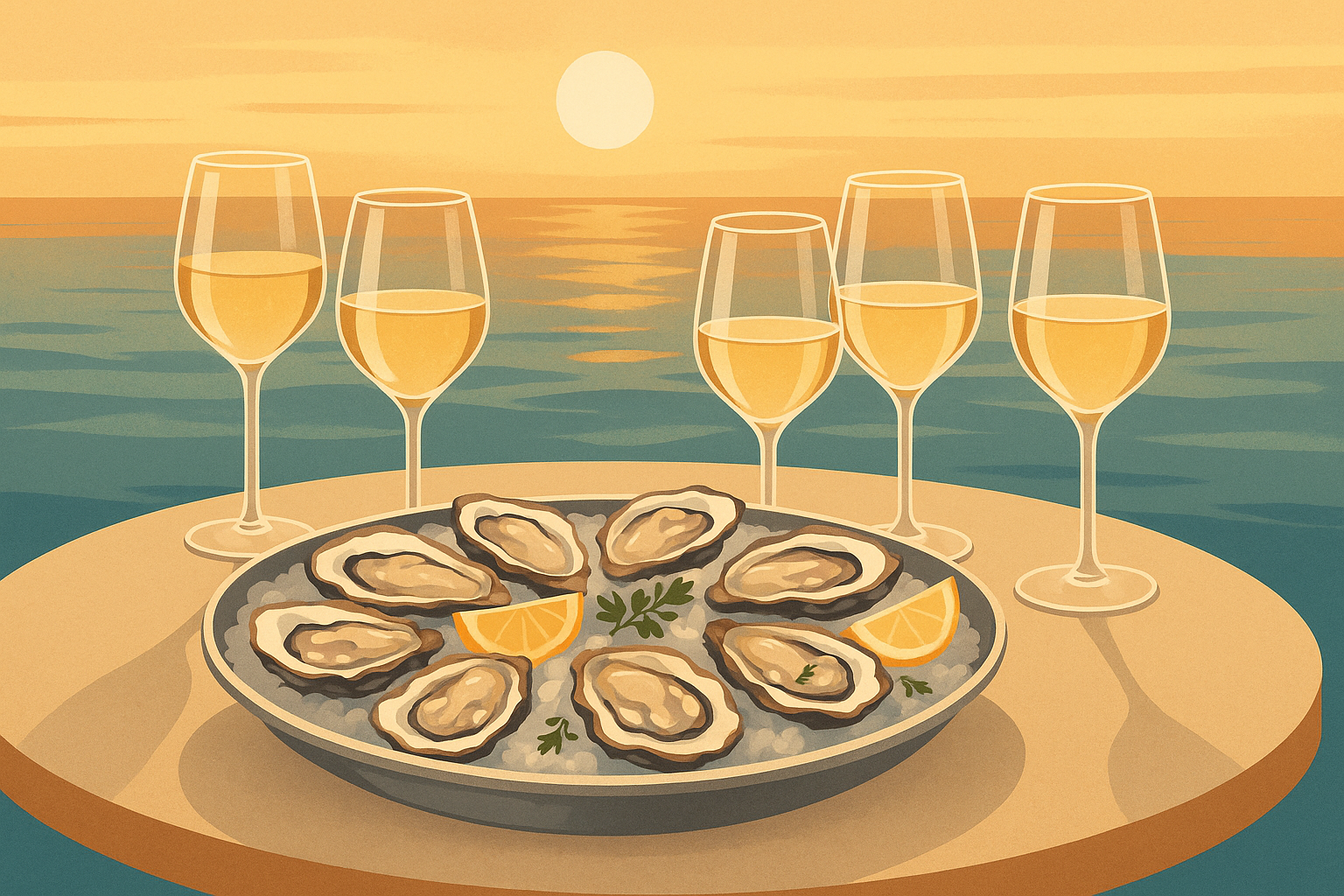Fresh oysters and wine are a perfect match, but choosing the right wine can make all the difference. Here's a quick guide to the top six wines that pair beautifully with oysters, enhancing their sweet, briny flavors:
- Chablis: Crisp, mineral-driven, with zesty citrus notes. Perfect for balancing the brininess of oysters.
- Champagne: Fine bubbles and bright acidity cleanse the palate and complement the oysters' oceanic flavors.
- Muscadet: A light, bone-dry white with high minerality and citrus notes, ideal for enhancing oyster sweetness.
- Sauvignon Blanc: Zesty, herbaceous, and refreshing - balances the briny and delicate texture of oysters.
- Albariño: Light-bodied with citrus and coastal salinity, making it a natural match for oysters' oceanic essence.
- American Sparkling Wine: Crisp bubbles and bright fruit flavors offer a homegrown twist for oyster pairings.
Quick Comparison Table
| Wine Type | Key Flavor Notes | Why It Works with Oysters | Serving Temp |
|---|---|---|---|
| Chablis | Citrus, minerality, high acidity | Balances brininess, highlights sweetness | 48–52°F |
| Champagne | Bubbles, apple, toast | Cleanses palate, enhances briny flavors | 45–48°F |
| Muscadet | Bone-dry, saline, citrus | Balances salinity, enhances sweetness | 46–50°F |
| Sauvignon Blanc | Citrus, green herbs, crisp | Complements briny character | 45–48°F |
| Albariño | Citrus, peach, coastal salinity | Highlights sweetness, oceanic essence | 48–50°F |
| American Sparkling | Crisp bubbles, bright fruit | Pairs well with a variety of oysters | 47–50°F |
These wines are best served chilled and paired with oysters like Little Wicomico's Blackberry® Oysters, known for their balanced sweet and salty flavor. Whether it's the minerality of Chablis or the effervescence of Champagne, each wine enhances the oysters' natural taste for a memorable dining experience.
Wine Pairings with Oysters - August 4, 2022
Wine and Oyster Pairing Basics
To choose the right wine, it's important to understand Virginia oysters. For example, Little Wicomico's Blackberry® Oysters offer a mix of sweet and briny flavors, making them versatile for wine pairings [1].
When picking a wine, focus on two key traits:
Acidity and Minerality: Wines with high acidity and a mineral-forward profile balance the oysters' salinity and highlight their subtle ocean flavors [1]. This aligns with the saying, "what grows together, shows together" [3].
Here’s a quick guide based on oyster flavor profiles:
| Oyster Profile | Recommended Wine Style | Pairing Effect |
|---|---|---|
| Sweet & Briny (Blackberry®) | Unoaked Chardonnay | Enhances sweetness; delivers a clean finish |
| Full-Bodied (Smith Point) | High-Acid White | Balances richness; emphasizes briny flavors |
| Mineral-Forward | Bone Dry White | Highlights natural sweetness |
"A bright, crisp white wine is the quintessential beverage pairing for freshly shucked oysters. The right wine cuts through the oysters' saltiness while complementing their delicate ocean essence." [1]
In February 2024, Little Wicomico highlighted their dedication to wine pairings that "honor the oysters' natural, exquisite flavor" [1]. Their approach ensures the wine enhances the oysters' flavors without overpowering them, creating a perfect balance that celebrates both elements.
1. Chablis
Chablis, a French white wine, is a perfect match for fresh oysters. Its zesty citrus notes and subtle white flower aromas pair beautifully with its light body and vibrant acidity. The wine's mineral-rich flavor, influenced by the clay, marl, and Kimmeridgian limestone in its soil [5], complements the salty, oceanic taste of oysters seamlessly. This mineral-driven profile plays a key role in enhancing the pairing, as outlined below.
Key Characteristics:
- Aroma: Zesty citrus and delicate white flowers
- Body: Light and refined
- Flavor: Bright acidity with strong mineral tones
- Finish: Crisp and refreshing
"The wine style is so pairable because of its citrus and white flower aromas, lifted body, acid-driven profile and minerality." [4]
| Chablis Feature | Effect on Oyster Pairing |
|---|---|
| High Acidity | Balances briny flavors |
| Mineral Notes | Complements oceanic taste |
| Citrus Elements | Highlights oyster sweetness |
| Clean Finish | Refreshes the palate |
For the best experience, serve Chablis well-chilled. This enhances its crisp acidity and ensures each sip refreshes your palate, making every bite of oyster even more enjoyable.
2. Champagne
Following our look at crisp Chablis, Champagne is another standout companion for fresh oysters. Its lively bubbles and bright acidity create a delightful contrast in texture and flavor, making every bite feel indulgent.
Key Characteristics:
- Bubbles: Fine and persistent
- Acidity: Crisp and invigorating
- Flavor: Notes of apple, pear, and a touch of toast
| Champagne Feature | Why It Works with Oysters |
|---|---|
| Effervescence | Refreshes the palate after each bite |
| Bright Acidity | Balances the oyster's richness |
| Subtle Complexity | Enhances the briny, oceanic flavors |
| Dry Finish | Complements the oyster's natural salinity |
The combination of Champagne's bubbles and acidity enhances the experience of eating oysters. As wine expert Carolyn Covington explains:
"Champagne, the quintessential celebratory drink, offers a luxurious pairing for oysters. The effervescence of Champagne's bubbles creates a sensational textural contrast with the oysters, enhancing the dining experience. The wine's bright acidity, coupled with its subtle notes of apple, pear, and toast, beautifully complements the oyster's intricate flavors. This makes it a match suitable for a special (or any) occasion!" [2]
Pairing Tips:
- Opt for brut Champagne for a perfectly dry finish.
- Align regional Champagnes with the type of oysters you're serving.
- Add a touch of lemon zest or mignonette sauce to heighten the flavors.
3. Muscadet
Shifting away from Champagne's bubbles, let's talk about Muscadet - a crisp, light white wine from France's Loire Valley that’s perfect with fresh oysters. Made from Melon de Bourgogne grapes, Muscadet has some standout qualities.
Key Characteristics:
| Feature | Description | Pairing Benefit |
|---|---|---|
| Acidity | High and refreshing | Cleanses the palate between oysters |
| Minerality | Saline, pronounced notes | Highlights the briny flavors of oysters |
| Texture | Light to medium-bodied | Matches oysters' delicate texture |
| Flavor Profile | Citrus, green apple, mineral | Adds a bright zest to the experience |
Muscadet’s high acidity and saline minerality naturally enhance the briny taste of oysters. This wine’s character is shaped by Atlantic sea breezes, especially in the Muscadet Sèvre et Maine region, which is renowned for producing top-tier Muscadet.
Wine expert Carolyn Covington praises this pairing:
"Muscadet is probably the least well known wine on this list, but it's my favorite pairing with oysters!" [2]
Shopping Guide:
- Entry-level Muscadet Sèvre et Maine ($14-$16): Offers vibrant citrus and mineral flavors.
- Premium 'sur lie' versions ($20-$25): Brings added depth with hints of bread and preserved lemon.
For the best experience, look for bottles labeled "sur lie." These wines are aged on their lees for at least six months, giving them a creamy texture and subtle yeasty notes that complement oysters beautifully.
Serving Tips:
- Serve chilled for maximum refreshment.
- Opt for "sur lie" versions to enjoy added complexity.
- Stick with Muscadet Sèvre et Maine for reliable quality.
4. Sauvignon Blanc
Sauvignon Blanc is a fantastic companion to fresh oysters, offering a perfect balance that highlights the oysters' natural flavors.
Key Characteristics:
| Feature | Description | Why It Works |
|---|---|---|
| Acidity | Bright, crisp | Balances briny flavors |
| Flavor Profile | Citrus, green herbs | Enhances natural taste |
| Body | Light to medium | Matches delicate texture |
| Minerality | Prominent | Complements oceanic notes |
This wine's crisp acidity, herbal notes, and minerality work together to refresh and elevate the oysters' briny essence, making each bite even more enjoyable.
Serving Tips:
- Serve chilled between 45–50°F for the best flavor.
- Use a white wine glass to enhance its aromas.
- Let the wine sit for a minute or two after pouring to fully develop its flavors.
sbb-itb-5051793
5. Albariño
Albariño, much like Sauvignon Blanc, offers a refreshing option for pairing with oysters, but with a coastal twist. This light-bodied white wine is bright, crisp, and slightly salty - perfect for complementing the briny nature of oysters.
Flavor Profile and Characteristics:
| Feature | Description | Pairing Benefit |
|---|---|---|
| Primary Flavors | Citrus, peach, grapefruit, apricot | Highlights oysters' natural sweetness |
| Body | Light and refreshing | Maintains the delicate taste of oysters |
| Acidity | Bright and crisp | Naturally cleanses the palate |
| Unique Quality | Coastal salinity | Enhances the oceanic essence of oysters |
| Alcohol Content | 12-14% ABV | Provides balanced strength for seafood |
Albariño's strong maritime character is especially evident in wines from Rias Baixas, where it dominates 85% of grape production [8]. This connection to the sea makes it an obvious choice for fresh oysters.
Serving Tips: Chill it well before serving in a white wine glass. Start by enjoying its mineral and citrus notes while cold; as it warms slightly, you'll notice richer fruit flavors emerging.
"Albariño is an excellent food pairing wine given its high acidity and slight bitterness (phenolics), which allow it to act as a palate-cleanser to a wide variety of food textures (oily, creamy, chewy, etc)."
– Madeline Puckette, James Beard Award-winning author [6]
You can find Albariño bottles priced between $15 and $50 [7]. For the best experience, opt for wines from recent vintages (within one to two years of production) to enjoy their peak acidity and lively fruit notes [6].
6. American Sparkling Wine
American sparkling wines offer a vibrant, homegrown option that pairs beautifully with oysters, thanks to their crisp bubbles and refreshing acidity.
Key Characteristics:
| Feature | Description |
|---|---|
| Temperature | 47-50°F (8-10°C) |
| Ice Bath Time | 20-25 minutes |
Serving the wine at the right temperature enhances its flavor, making it an ideal match for oysters. The gentle bubbles and bright acidity cleanse the palate with each sip, offering a similar experience to Champagne but with a distinct American twist.
Temperature Tips: Use an ice bath with a handful of salt to chill the bottle effectively. Submerge it for 20-25 minutes, then check the temperature. Keep the bottle in the ice bath during service to maintain the chill, but avoid letting it drop below 47°F (8°C). This quick method ensures the wine stays at its best.
Pro Tip: Always return the bottle to the ice bath between pours to keep it perfectly chilled [9].
Wine and Oyster Pairing Chart
Pairing the right wine with oysters can bring out the best flavors in both. Use this chart as a handy guide to enhance your next oyster tasting.
| Wine Type | Taste Profile | Best Oyster Match | Serving Temp | Why It Works |
|---|---|---|---|---|
| Chablis | Mineral-driven, crisp acidity, citrus notes | Blackberry® Reserve Oysters | 48–52°F | Highlights brininess with citrus hints |
| Champagne | Fine bubbles, bright acidity, toasted notes | Smith Point Oysters | 45–48°F | Bubbles cleanse the palate, enhance brine |
| Muscadet | Bone-dry, high minerality, light body | Rock Hole Oysters | 46–50°F | Balances salinity, enhances sweetness |
| Sauvignon Blanc | Zesty citrus, herbaceous, crisp finish | Peachtree Oysters | 45–48°F | Matches the oysters' briny character |
| Albariño | Floral notes, stone fruit, coastal minerality | Blackberry® Oysters | 48–50°F | Complements the sweet-salty profile |
| American Sparkling | Crisp bubbles, bright fruit, clean finish | Farm Fresh Oyster Sampler | 47–50°F | Pairs well with a variety of oysters |
When choosing a wine, think about the oysters' merroir - the local flavors influenced by their environment. Crisp, high-acid white wines often pair beautifully with these nuanced tastes [1][10].
"With our oysters, you really taste the animal." - Bernie Murphy, Rappahannock oyster rep [10]
Tip: Keep wines chilled in an ice bath to maintain the suggested serving temperatures. This ensures the flavors stay crisp and refreshing throughout your meal.
Serving and Preparation Guide
Once you've selected the perfect wine, it's time to prepare and serve oysters the right way. Follow these steps to ensure the best experience.
Safe Shucking Techniques
Protect your hands with a thick towel or shucking gloves before you begin. Hold the oyster with the flat side facing up and the rounded side down. For Little Wicomico's Blackberry® Reserve Oysters, insert the shucking knife about 2-3 mm from the shell's rim, opposite the hinge. Gently wiggle the knife back and forth with light pressure until you break through. Once inside, carefully cut the muscle connecting the shells. After shucking, keeping the oysters at the right temperature is key.
Temperature Control
| Item | Ideal Temperature | Storage Method |
|---|---|---|
| Live Oysters | 35-40°F | Refrigerated, cup-side up |
| Shucked Oysters | Below 40°F | In liquor, refrigerated |
| White Wines | 45-52°F | Ice bath or wine cooler |
| Sparkling Wines | 45-48°F | Ice bath |
Classic Accompaniments
Enhance your oysters with a traditional mignonette sauce. Combine finely minced shallots, red wine vinegar, and freshly cracked black pepper. For Little Wicomico's Smith Point Oysters, this bright sauce pairs perfectly with their natural brininess, especially alongside crisp white or sparkling wines.
Storage Guidelines
- Keep live oysters in the refrigerator, covered with a damp cloth. Avoid letting them sit in melting ice or standing water.
- Check that the shells are tightly closed for maximum freshness.
- Shucked oysters stored in their liquor can stay fresh for up to seven days if refrigerated properly.
Presentation Tips
Serve oysters on a bed of crushed ice to keep them cold and visually appealing. Arrange them carefully to preserve their liquor. For wine service, chill the appropriate glassware and keep bottles in temperature-controlled ice baths nearby. Before serving, perform a quick freshness check:
Quality Check
- Visual inspection: Ensure the shells are tightly closed.
- Liquid check: The liquor should be clear and smell fresh.
- Meat examination: The oyster meat should look plump and moist.
Summary
Pairing the right wine with Little Wicomico's premium oysters takes the tasting experience to the next level. With four generations of expertise in oyster farming, these Virginia-grown delights are matched with wines that highlight their unique flavors.
"The right wine cuts through the oysters' saltiness while complementing their delicate ocean essence" [1]
Crisp, acidic whites like Chablis and Champagne pair beautifully with the Blackberry® Reserve Oysters, while Sauvignon Blanc enhances the flavors of Smith Point Oysters. These thoughtful pairings, rooted in Little Wicomico's rich heritage, bring out the best in every bite of these premium oysters.
FAQs
Why is Chablis considered one of the best wine pairings for fresh oysters, and how does its flavor profile complement them?
Chablis is widely regarded as one of the best wine pairings for fresh oysters because of its crisp acidity and mineral-driven profile. These qualities perfectly complement the briny, delicate flavors of oysters without overpowering them. The wine's vibrant acidity balances the natural salinity of the oysters, creating a refreshing and harmonious taste experience.
Additionally, Chablis often features subtle citrus and green apple notes that enhance the oysters' fresh, oceanic essence. Its clean, elegant finish makes it an ideal choice for elevating your oyster dining experience.
Why is Champagne such a great wine choice to pair with fresh oysters?
Champagne is an exceptional match for fresh oysters because its effervescence adds a lively contrast to the oysters' smooth, delicate texture. The crisp bubbles cleanse the palate, enhancing each bite and making the experience more refreshing.
Additionally, the high acidity in dry sparkling wines, like Champagne, balances the briny, mineral-rich flavors of oysters, creating a perfect harmony between the two. This pairing highlights the natural flavors of both the wine and the seafood, elevating your dining experience to a new level.
Why should wines like Muscadet and Sauvignon Blanc be served at specific temperatures when paired with oysters?
Serving wines like Muscadet and Sauvignon Blanc at the right temperature is essential to enhance their flavor and complement the delicate, briny taste of oysters. These wines are best served chilled, typically between 45°F and 50°F, as this temperature range preserves their crisp acidity and fresh, citrusy notes.
If served too warm, the wine may taste flat or overly alcoholic, overshadowing the oysters' subtle flavors. Conversely, serving it too cold can mute the wine's aromatic complexity. By keeping the wine at the ideal temperature, you create a harmonious pairing that elevates the dining experience.





